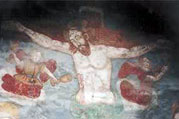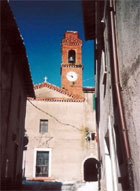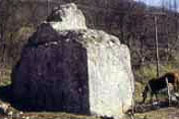The town currently has 3 churches.
La chiesa di San Nicola

The church of San Nicola, which occupies a central position, is now the main parish. The oldest information in relation to this church is contained in the register of the parishes of the diocese of Rieti of 1398. The current appearance is very dissimilar from its foundation as part of the presbytery and the church tower. It has a single nave, a room with two side altars where there are two paintings representing the Flight into Egypt (1819) and Our Lady of the Rosary (1821) recently restored with the coordination of the Superintendence of Artistic Heritage, by Masi Mara and Augusto Ricci and following an internal renovation of the church run by the Galmacci Ciferri family. The church of San Nicola is always available for weddings, since it has a community of Indian priests based at the parish house, just a simple reservation at the Presidency of the relevant committee or at the parish house of Paganico Sabino.
Santa Maria dell'Annunciazione

The church of St. Mary of the Annunciation, which until last year was in a state of neglect, the roof being broken and reduced to mere ruins, has been restored in 2001 for tourist accommodation and religious services. The work, conceived and funded under the EU program called "Diffused Hotel", has allowed the recovery and the call to new life of a building so dear to the people of Paganico Sabino and so tied to its history, with the final rescue of the fourteenth century fresco on the right wall and the other series of paintings discovered in the course of work.
The history of this primitive ecclesiastical settlement is to be reconstructed both on the basis of documented evidence and the reading of the wall surface, which allows us to retrieve the interventions occurred over the centuries. the founding date is uncertain, but certainly as early as 1398 there was a "ecclesia S. Marie de Paganica est ecclesia per se".
At the bottom of the right wall of the nave, a shallow arched niche, is a fresco of the Crucifixion probably dating from the early decades of the sixteenth century. The recent restoration has showed that the entire right wall is covered with pictorial cycles, while others frescoes are situated in the chapel, the oldest building. Projects are under way for the restoration of the entire painted area that is approximately 60 square meters.
The Church of St. John the Baptist, is now an integral part of the cemetery. The oldest sign on the structure in from 1398. In 1713 the church was very probably already part of the cemetery, since it was mentioned as "sepulchral". the church is often described as simple and devoid of frescos from the inside. On the external front, however, there are torn pieces of pluteus sandstone that appear to be part of a single decorative complex of the early Middle Ages and their nature would seem to suggest an era of implementation ranging from the Eighth and Ninth centuries.
The building, now used as city hall, was originally occupied by the Church of San Giorgio. With a single nave and a circular apse, it had been built just outside the town and certainly not before 1713 and after 1765 (two dates of Episcopal visits). It had a hard time, and just in the Nineteenth century the town became interested in its premises. With the "recent" (80's) restoring of the municipal seat it has completely lost traces of its architecture. What remains is the memory of the "sacred" site, recently reconfirmed by the placing of a statue depicting St George and the renewed celebration of the Feast of the Holy by volunteers from the neighborhood.
EXCURSIONS AND PLACE TO VISIT |













